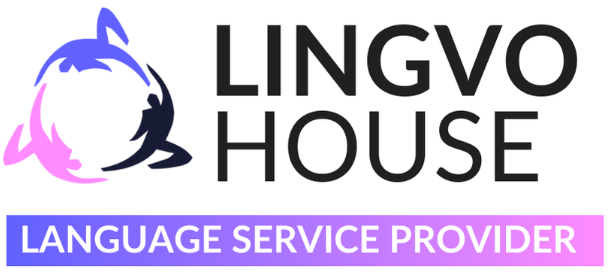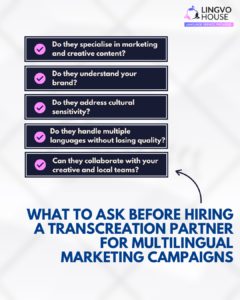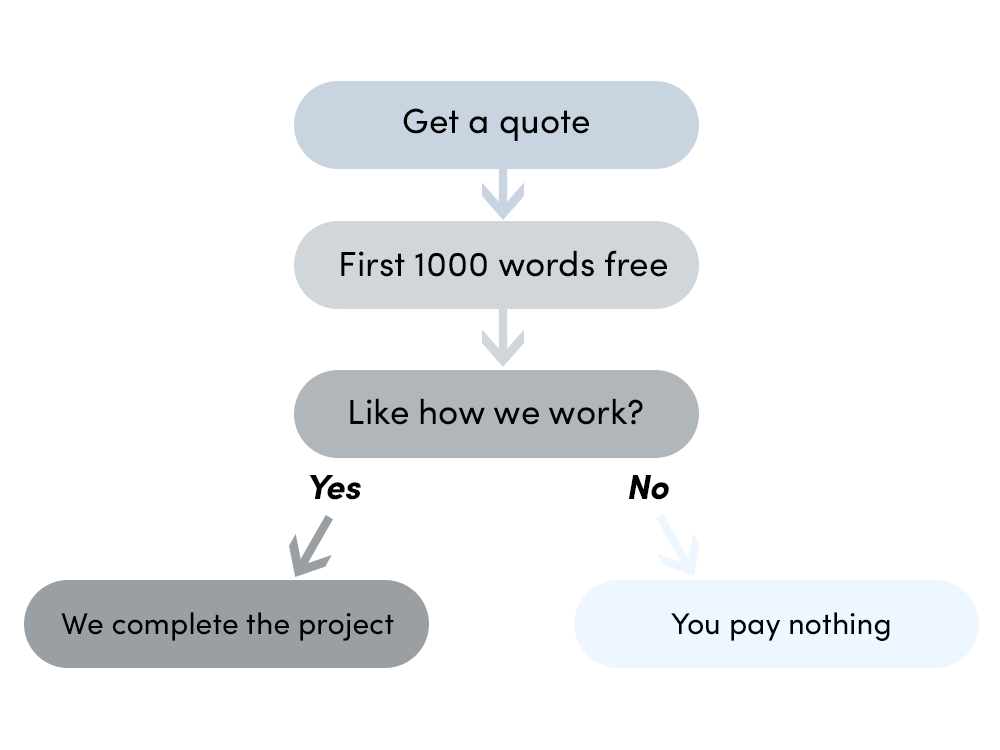Global marketing teams spend millions crafting the perfect campaign message, only to watch it lose its magic the moment it crosses borders. Treating creative content like a technical manual that just needs translating. Here’s why transcreation has become the secret weapon of successful global brands, and how to find partners who get it right.
When Translation Kills Your Campaign (And Why Most Agencies Don’t Understand the Difference)
Picture this: your brilliant tagline that tested beautifully in London gets translated into German and suddenly sounds like an instruction manual. Your witty social campaign that drove engagement through the roof becomes awkward and stilted in Spanish. Your emotional brand story falls completely flat in Japanese markets. This isn’t a translation problem, it’s a transcreation problem. And most marketing teams don’t understand the difference until it’s too late. Translation focuses on accuracy and meaning. Transcreation focuses on impact and emotion.
When Nike’s “Just Do It” became “Just Do It” in every market, that wasn’t translation – that was transcreation working perfectly. The words stayed the same because the attitude translated universally. But when KFC’s “finger-lickin’ good” became “eat your fingers off” in Chinese markets, that was translation without transcreation. Accurate words, devastating impact. The transcreation industry has exploded because global brands finally recognise that their creative content needs creative treatment, not just linguistic conversion. It’s a specialised field that sits at the intersection of copywriting, cultural consulting, and brand strategy.
The Hidden Complexity of Global Creative Content
What makes transcreation so challenging isn’t just the language barrier – it’s the cultural, emotional, and contextual barriers that most marketing teams never consider.
Cultural Context Shifts Everything
Humour doesn’t translate. What’s funny in Australia might be offensive in Germany. What’s aspirational in America might seem boastful in Japan. A successful transcreation partner understands these nuances and adapts accordingly.
Emotional Triggers Vary by Market
The emotional drivers that make people buy differ dramatically across cultures. Fear-based messaging might work in some markets whilst completely backfiring in others. Success stories resonate differently. Even colour psychology changes across cultures.
Legal and Regulatory Landscapes
Different markets have different advertising standards, claim substantiation requirements, and cultural sensitivities around everything from health claims to environmental messaging. Your transcreation partner needs to navigate these whilst keeping your campaign impact intact.
Platform and Media Differences
Social media platforms vary by region. WeChat isn’t Twitter. LinkedIn usage differs across cultures. Your transcreation partner should understand not just what to say, but where and how to say it in each market.
The Real Cost of Getting Transcreation Wrong
Poor transcreation doesn’t just waste marketing budgets, it can actively damage brands. Consider these real-world consequences:
Brand Perception Damage: When campaigns miss the cultural mark, they don’t just fail to resonate – they actively harm brand perception. Consumers remember brands that got it wrong.
Market Entry Delays: Campaigns that require extensive revision or complete reworking delay market entry and competitive positioning.
Wasted Media Spend: Creative content that doesn’t connect means wasted media investment. You’re paying to broadcast messages that don’t work.
Internal Team Frustration: Local marketing teams become frustrated when global campaigns don’t adapt to their markets, creating internal friction and reducing campaign effectiveness.
5 Signs Your Transcreation Partner Gets Creative Content
1. Do They Think Like Copywriters or Translators?
Here’s the first test: when you brief them on a campaign, do they ask about tone of voice, target audience emotions, and brand personality? Or do they focus on word counts and delivery dates?
Creative transcreation partners think like the copywriters and creative directors they essentially are. They want to understand your brand’s attitude, your audience’s motivations, and your campaign’s emotional goals. They ask questions about what you’re trying to make people feel, not just what you’re trying to make them understand.
Look for partners who request creative briefs, ask to see your brand guidelines, and want to understand your campaign strategy. The best transcreation specialists often have copywriting or advertising backgrounds themselves.
2. Can They Show You Campaigns That Worked (Not Just Pretty Words)?
Anyone can produce fluent, culturally appropriate copy. What separates great transcreation partners is their ability to produce copy that drives results.
Ask for case studies that include performance metrics. Did their transcreated campaigns achieve better engagement rates than direct translations? Can they show examples where their creative adaptation improved campaign performance in local markets?
The best partners maintain relationships with their clients specifically because they deliver measurable improvements in campaign effectiveness. They should be able to walk you through examples where their creative approach made a genuine business difference.
3. Will They Push Back When Your Creative Won’t Work (Or Just Take Your Money)?
Excellent transcreation partners are collaborative, not just accommodating. If your campaign concept fundamentally won’t work in a target market, they should tell you – and propose alternatives.
Look for partners who engage in creative problem-solving rather than just accepting briefs. They should be comfortable explaining why certain approaches won’t work and offering strategic alternatives that maintain your campaign’s core objectives whilst adapting to local markets.
This consultative approach is what separates transcreation specialists from translation providers trying to offer creative services. The specialists understand they’re part of your creative team, not just a service provider.
4. Do They Have Real Cultural Insight (Or Just Native Speakers)?
Being a native speaker doesn’t automatically make someone culturally fluent for marketing purposes. Your transcreation partner needs deep understanding of consumer behaviour, cultural trends, and market dynamics in each target region.
Look for partners who employ cultural consultants, maintain local market expertise, and can provide context beyond just language adaptation. They should understand local competitive landscapes, cultural moments, and consumer sentiment trends that might affect your campaign timing or messaging.
The best transcreation partners often have team members who’ve worked in advertising or marketing within the target markets, not just linguists who happen to be from those regions.
5. Can They Scale Creative Quality Across Multiple Markets Without Everything Falling Apart?
Global campaigns often launch simultaneously across 10+ markets. Your transcreation partner needs systems to maintain creative consistency whilst allowing for local adaptation.
This requires sophisticated project management, quality control processes, and creative oversight that goes well beyond typical translation workflows. Look for partners who can demonstrate experience managing large-scale creative projects across multiple regions simultaneously.
They should have processes for maintaining brand voice consistency, managing creative approval cycles, and ensuring that local adaptations still feel like part of the same global campaign.
The Technology Factor: How AI Is Changing Creative Transcreation
Artificial intelligence is beginning to impact transcreation, but not in the way most people expect. AI can help with initial creative generation and cultural context research, but the strategic thinking and emotional intelligence required for effective transcreation remain fundamentally human.
The most sophisticated transcreation partners are using AI tools to enhance their creative process – generating initial concepts, researching cultural trends, and analysing competitor messaging – whilst maintaining human oversight for strategic decisions and creative refinement.
For marketing teams, this means looking for partners who are thoughtfully integrating technology to improve their creative process rather than replacing human creativity with automated solutions.
Building Successful Transcreation Partnerships
The most successful transcreation relationships feel more like creative agency partnerships than vendor relationships. Here’s how to structure them for success:
Treat Them as Creative Partners, Not Service Providers
Include your transcreation team in campaign development discussions, not just execution phases. Their cultural and market insights can inform your global strategy, not just adapt it.
Invest in Onboarding and Brand Education
Great transcreation requires deep brand understanding. Invest time in educating your transcreation partners about your brand voice, target audiences, and strategic objectives. The upfront investment pays dividends in campaign effectiveness.
Create Feedback Loops with Local Markets
Establish processes for local market teams to provide feedback on transcreated content. This creates continuous improvement and helps your transcreation partners refine their understanding of what works in each market.
Plan for Iteration and Refinement
Unlike technical translation, creative transcreation often requires iteration. Build time and budget for creative refinement based on local market feedback and performance data.
The Strategic Imperative
Global marketing success increasingly depends on cultural fluency, not just linguistic accuracy. Brands that invest in sophisticated transcreation partnerships create competitive advantages in international markets whilst those that treat creative content like technical documentation continue struggling with campaign effectiveness abroad.
The transcreation industry has matured because global brands recognise that their creative assets represent significant investments that deserve expert treatment. The most successful international marketing teams now view transcreation as a strategic capability rather than a tactical service.
Moving Forward: What This Means for Marketing Leaders
For marketing leaders responsible for global campaigns, transcreation partner selection has become a strategic decision with significant business implications. The right partners can accelerate international expansion, improve campaign ROI, and strengthen brand perception across diverse markets.
The wrong partners waste marketing budgets, delay market entry, and can actively damage brand equity in new markets.
The key is understanding that transcreation sits at the intersection of creative services, cultural consulting, and strategic marketing. The best partnerships combine all three elements to create campaigns that resonate globally whilst feeling locally relevant.
Success requires treating transcreation partner selection with the same rigour applied to creative agency relationships, because that’s essentially what they are – specialised creative agencies with deep cultural and linguistic expertise.
Global marketing teams that master transcreation partnerships gain significant competitive advantages in international markets. The investment in finding the right partners and building effective relationships pays dividends in campaign effectiveness, market entry speed, and long-term brand building across diverse cultural contexts.
If your next board update needs certainty, get a quick quote to lock in costs and delivery windows: https://www.lingvohouse.com/quick-quote/





